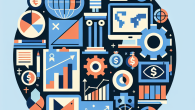
Can Deglobalisation Be Quantified Through Trade Elasticities?
Unpacking the Fed’s Balancing Act: Inflation, Interest Rates, and Market Consequences
Allow me to paint the scene for you. Picture a bespectacled economist with a bow tie standing atop a mountain of data, squinting into the horizon with a monocle—not unlike yours truly. Why? Because deciphering the Federal Reserve’s policy decisions is as much art as it is science. The Fed’s moves on inflation and interest rates are more than mere technicalities. They are tectonic shifts in the financial landscape—ripples that become waves from Wall Street to households in Wichita.
In this article, we shall firmly grasp the complexities of the Federal Reserve’s ongoing struggle to balance economic growth with inflation containment. This balancing act, akin to a tightrope walker lugging a piano, has profound implications for global markets, currencies, and everyday decision-making. As always, I, Dr. Alistair P. Whitmore, am your guide through this intricate maze.
What Is the Federal Reserve Balancing, Exactly?
The Federal Reserve—affectionately or otherwise known as “the Fed”—is mandated by Congress to promote maximum employment and stable prices. This, dear readers, is akin to juggling two cats and a chainsaw.
Inflation Control
To combat inflation, the Fed typically raises interest rates, making borrowing more expensive. The logic is frightfully simple: expensive credit begets less spending, which in turn eases upward pressure on prices.
Economic Growth
On the flip side, if the Fed bites too hard on the rate hike apple, it could spook investment, freeze credit markets, and hurl the economy into recession—a sensation not dissimilar to discovering one’s champagne has gone flat.
The Mechanism: Interest Rates as the Fed’s Primary Tool
Let’s deconstruct how this monetary ballet plays out in real time.
Raising Rates: The Cooling Effect
Higher interest rates typically:
- Make mortgages, credit cards, and business loans more expensive
- Encourage saving (who doesn’t love earning more on a savings account?)
- Slow down consumer spending and corporate expansion
The underlying goal? Reduce inflation by squelching the fire of excess demand. For context, during 2021–2022, inflation in the U.S. touched 40-year highs of over 9%, prompting a rate increase campaign not seen since Alan Greenspan’s heyday.
Cutting Rates: Stimulating a Sluggish Economy
Conversely, when the Fed lowers rates, it’s effectively removing the parking brake from the economy:
- Loans become cheaper, spurring business investment
- Consumers feel more comfortable spending
- Stock prices often rise, bringing smiles to investors across Manhattan (and Montana!)
But such measures must be timed to perfection. Like soufflés and diplomatic summits, everything depends on balance.
The Data Behind Every Decision
The Fed does not act on instinct or whimsy. It leans heavily on an ocean of data—some of which would make even the most hardened statistician break into a nervous sweat. Key indicators include:
- Consumer Price Index (CPI): The gold standard for measuring inflation
- Unemployment Rate: To gauge labor market robustness
- GDP Growth: A barometer for economic health
- Wage Inflation: Rising paychecks can signal sustained inflationary pressure
If wage growth is robust while unemployment remains low, the Fed may decide that inflation is pesky enough to warrant further tightening—even at the cost of some short-term market gastric distress.
Global Implications of Fed Decisions
The world listens when the Fed speaks, and rightly so. U.S. interest rate shifts influence:
1. Global Capital Flows
When U.S. interest rates rise, capital often flows back into Dollar-denominated assets due to higher yields. This can drain investment from emerging markets, causing their currencies to depreciate and inflation to rise.
2. Currency Valuations
The dollar’s strength typically climbs with higher U.S. interest rates. A strong dollar may benefit importers but harms exporters. Multinationals feel this pressure in their earnings statements, often delivered in tones of feigned optimism.
3. Commodity Prices
Most global commodities—be it oil, copper, or the occasional soybean—are priced in dollars. Consequently, a stronger greenback can depress commodity prices, echoing loudly across producer nations.
The Dilemma: Has the Fed Gone Too Far or Not Far Enough?
And now we arrive at the central question: Has the Fed calibrated its approach correctly?
Some market watchers argue the Fed’s aggressive rate hikes may squelch economic momentum and nudge the U.S. into recession. Others retort that inflation remains too stubborn and deserves more medicine.
Recent comments by Fed Chair Jerome Powell suggest a “wait and see” approach—possibly signaling a pause. Still, uncertainty remains. The bond market is pricing a possible pivot, while labor markets continue to defy gravity like an over-caffeinated squirrel.
How Investors Should Respond
Here are a few recommendations from my well-worn economist’s notebook:
Diversify Across Sectors
During periods of tightening, rotate into defensive sectors like healthcare, utilities, and consumer staples. These industries tend to perform better when growth slows.
Watch Duration on Bonds
When interest rates rise, bond prices fall—especially long-duration bonds. Diversify into short-duration or inflation-protected securities like TIPS.
Keep an Eye on Global Equities
Some international markets may outperform when U.S. tightening weakens their currencies, especially those exporting to the U.S. Be judicious and selective, of course.
Conclusion: A Game of Patience, Not Panic
In sum, the Fed’s balancing act is less a binary choice than an ongoing calibration—the kind of nuanced decision-making one expects from a watchmaker or a Michelin-starred chef. The maneuvering around interest rates and inflation will continue to define market behavior, wealth strategies, and policy debates for years to come.
My dear readers, the lesson remains clear: Stay informed, stay diversified, and never bet against a central banker with a spreadsheet in one hand and global impact in the other.
For more on macroeconomic trends and market insights, visit our About Us page or reach out to our team via our Contact section. Keep your wits sharp and your portfolios sharper.









Leave a Reply